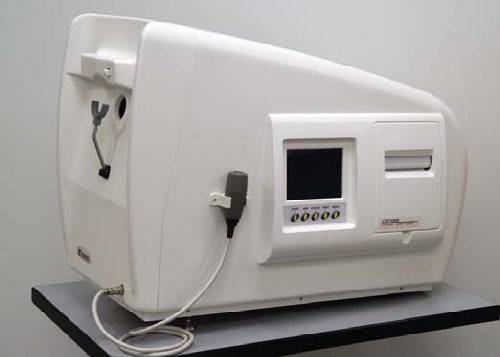Takagi Glare Tester CGT-1000 for Contrast Sensitivity and Glare Testing in Normal Individuals and Cataract Patients
Purpose: To investigate the sensitivity and repeatability of the Takagi Contrast Glare Tester CGT-1000 in normal individuals and those with cataracts.
Methods: A prospective observational study was performed. The Takagi Contrast Glare Tester measures contrast sensitivity (CS) at 6 target sizes and 13 contrast levels (2.00 to 0.34 logCS). Testing follows a method of descending limits paradigm with a single reversal determining threshold. The CGT-1000 was administered with and without glare in 95 eyes of 61 cataract patients and 13 controls. The percentage fl oor (unable to see the highest contrast) and ceiling (able to see the lowest contrast) effects and correlations between CS and cataract grades were determined. The repeatability was evaluated using Bland-Altman limits of agreement and expressed as the coeffi cient of repeatability (COR). Factor analysis was used to test for redundancy within the 6 spatial frequencies.
Results: In normal individuals, a high rate of ceiling effect varying with target size was noted—for 6.3°, 4.0°, 2.5°, 1.6°, 1.0°, 0.7°, ceiling effects were 68%, 58%, 18%, 11%, 4%, 2%, respectively, for no glare, and 47%, 42%, 8%, 2%, 2%, 2%, respectively, with glare. In cataract patients, floor effects were noted—3%, 0%, 3%, 7%, 19%, 62%, respectively, for no glare, and 3%, 3%, 6%, 14%, 44%, 79%, respectively, with glare. Correlations with cataract grades ranged from 0.10 to 0.61, being best for nuclear cataract. Repeatabilities expressed as COR were ±0.11, ±0.14, ±0.28, ±0.38, ±0.38, ±0.47 logCS, respectively. All spatial frequencies loaded heavily on one factor, indicating no gain in information from testing multiple target sizes.

Figure 1. The Takagi Contrast Glare Tester CGT-1000.
Conclusions: Sensitivity to the presence of cataract was good, but ceiling effects in normal individuals and fl oor effects in cataract patients limit accuracy. Repeatability was poor, but could be improved by testing less spatial frequencies more rigorously.
J Refract Surg. 2007;23:492-498.
Accepted for publication March 30, 2007
Konrad Pesudovs PhD
NH&MRC Centre for Clinical Eye Research, Department of
Ophthalmology, Flinders Medical Centre and Flinders University, Bedford Park, South Australia, Australia.
 Takagi Glare Tester
as PDF (113 Kb)
Takagi Glare Tester
as PDF (113 Kb)
![]()
Index of Papers
[ Welcome ][ Publications ]

